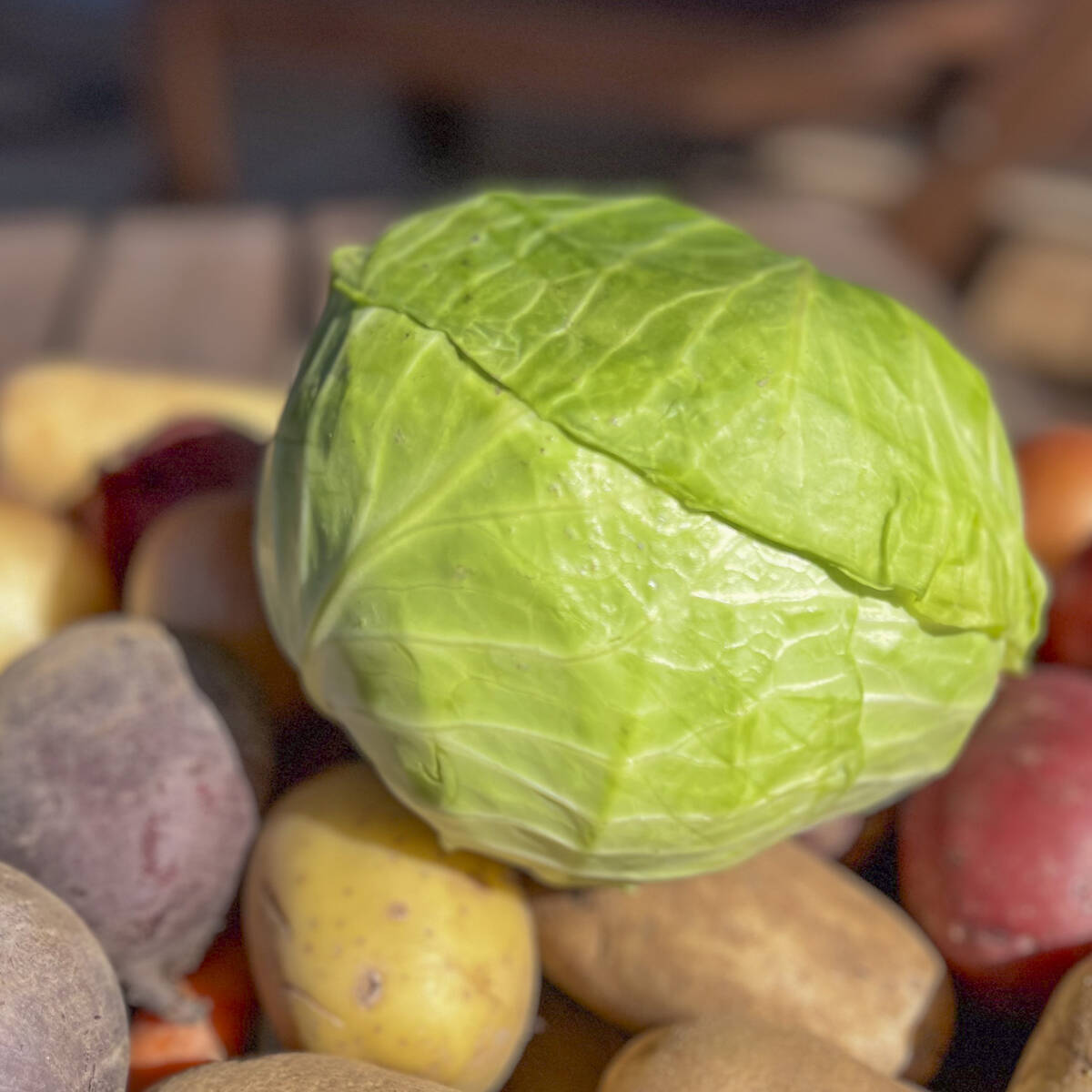My brother, the other Mr. Moore, would like to bring his class to tour your colony and learn about Hutterite life,” our teacher informed us one day. “As a token of appreciation, they’ll teach our class how to make macramé plant hangers.”
Patrick Moore was our middle grades teacher and his brother was a high school teacher in Winnipeg.
“What’s macramé?” we wondered.
Read Also

Cooking cabbage deserves revival
Cabbage recipes don’t need to be boring. Rediscover the taste, diverse uses and local Prairie food traditions of this leafy green
“For this project, please bring some sturdy cord, wooden beads and two-inch metal rings,” he said.
At home we rifled through our mothers’ and ankelas’ (grandmothers’) knitting baskets for heavy yarn. Unfortunately, whatever we found was too thin and too soft. But living on a farm enabled us find something suitable: baler twine.
“Now, what could we use for beads to decorate our plant hangers?”
Again, someone offered a workable suggestion: cutting old broom handles into one-inch pieces, drilling holes through the centres, then smoothing the edges with sandpaper.
When our visitors arrived several days later, we were equipped with bundles of baler twine, wooden beads and metal rings found in the garage – perhaps used to attach tarps to truck boxes. Most of the girls were eager and ready to learn the art of tying knots, but the boys participated because it was required.
“I’d rather work in the hog barn than do this kind of work,” one of them muttered.
I can still envision our instructor, one of the visiting high school girls, standing at the back of our classroom, her project attached to the wooden dowel of a pull-down world map. We gathered around as she taught us the basic knots: the wrapping, square and half-knot spiral. Using a combination of these, we could create any number and type of plant hangers.
Once we’d learned these essentials, we had to find spots around our classroom to attach our cords and start working. Cupboard door handles and picture frame nails became occupied. All the coat hooks in the hallway were soon used.
“I’ll hold your project while you tie the knots,” one of our guests offered when I couldn’t find a spot.
We sat down near my desk and I proceeded to fashion my first plant hanger.
“I hope you listened well because I’m not exactly sure how it’s done,” she said with a smile.
“Over, over, under,” I chanted, “under, under, over…” as I tied square knot after square knot. As I worked on my plant hanger, we chatted about what it’s like growing up on a farm.
“It must be wonderful being surrounded by farm animals, nature and wide-open spaces,” she said.
“Oh yes,” I agreed. “Just the other day I saw my first butterfly of the season fluttering around our lilacs. It was an orange and black one.”
“A monarch!” she exclaimed. “Too bad we didn’t come sooner. Then I’d have seen it too.”
Once we’d tied enough square knots and spiral knots, our instructor wanted to show us how to finish off the bottom of the hanger that would contain the follower pot.
“I’m going to need a potted plant,” she announced. “Could someone please bring one for me?”
“Elma, your Aunt Susie has house plants,” Mr. Moore said. “Could you ask her if we might borrow one of them, please?”
I hurried to my ankela’s house and returned with a plant growing in a rose bowl.
After that class, my Aunt Susie encouraged me to continue making plant hangers. She valued handicrafts and was always busy with crochet or embroidery work. She also grew numerous houseplants, so plant hangers would provide another attractive way to display them.

More than likely she considered tying knots a great way for me to strengthen my fingers. She provided me with Phentex, a synthetic yarn, and I plied several strands together to form a thick cord.
“Aren’t you going to work on your macrm?” she asked me one day, when I was visiting their house. My unfinished project had been untouched for several days.
“Macrm?” I questioned. “Oh, you mean macramé!”
“We’ll say made when you get it done,” she declared, and it was all the urging I needed to complete my plant hanger.
Over the years, I moved from basic three-foot plant hangers to elaborate floor-length creations. Coffee tables, plant stands, shelves and wall hangers soon became part of the décor in our house and at Ankela’s. Our washroom featured a macramé comb holder, towel rack and tissue container. Friends, relatives and other acquaintances asked me to make projects for them.
In 1994, I enrolled at Brandon University to begin studies for my education degree. The second course I took was Introduction to Teaching and one of its requirements involved planning and teaching the class a five-minute demonstration lesson.
I chose to teach how to tie a macramé square knot. My classmates were to create a macramé butterfly by tying four square knots.
“Today we’re going to make a monarch butterfly,” I announced dramatically. If I hadn’t had a stomach full of fluttering butterflies, I probably would have done much better with this lesson. Those who were somewhat familiar with this art form managed well, while others floundered.
After graduation, I began teaching in my home school. That fall, I taught some of the children the basic knots, enabling them to create macramé “candy” canes and other wall hangers that they decorated with holly and poinsettias.
Over time, however, interest in macramé dwindled like monarchs migrating to Mexico, and for some 20 years I didn’t create a single macramé plant hanger.
Nevertheless, “what goes around, comes around,” as one proverb states, just as butterflies heading to Mexico in fall will return the following spring.
Fast forward to a day in early summer of 2021 during the noon meal in our communal dining room.
“Do you still know how to make plant hangers,” asked Barb, one of my table mates. “Macramé is back in.”
“That’s something I’ll never forget,” I laughed. “I used to make plant hangers by the dozen.
“So, have you made any lately?”
“Not yet.”
“Well, if you’re not going to start soon, macramé will be out of style again.”
Over the course of several days, we returned to this topic. It was June, so I was busy wrapping up the school year, writing report cards, cleaning out cupboards and planning a high school graduation. I didn’t have much time for crafting, though our conversation compelled me to reminisce about how my macramé journey began.
During our trying pandemic times, I was more engaged in handicrafts than usual. Like many of my fellow Manitobans, I felt it would be beneficial to keep busy creating things rather than dwell too much on the perils of the pandemic.
That summer, after talking to Barb, I continued my macramé journey. On YouTube I found a macramé school that I joined, and all kinds of new ideas landed in my inbox. Interestingly, smaller, simpler projects were now popular. Some were shorter than a fly swatter.
Since I also enjoy crochet work, I’m planning to embellish a plant hanger with butterflies. While visiting my sister Linda at Crystal Springs Colony, I was approached by several women who asked me to teach them how to do macramé. Soon we were a half-dozen, happily knotting up plant hangers while chatting.
This past fall, I taught our children how to make plant hangers in art classes, and although we tied plenty of tight knots, those lessons were far less stressful and a lot more fun than the one from my university days. I expect this spring there will be brilliant butterflies – monarchs, that is – as we typically start and end our school year with raising and releasing butterflies. Those released in fall will head to Mexico, but we’ll expect them to return.
The adage, “what goes around, comes around” certainly holds true with monarchs, macramé and many other aspects of life.















